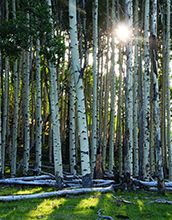New model quantifies competing effects of CO2 and heat stress to find balance point

Model finds balance point between competing effects of CO2 fertilization and heat stress.
In a world with rising levels of atmospheric carbon dioxide, experiments have shown that increased CO2 allows plants to photosynthesize more and use less water; however, warmer temperatures drive plants to use more water and photosynthesize less.
Will CO2 fertilization or heat stress win this competition?
A new NSF-supported study by researchers at the University of Utah published in Proceedings of the National Academy of Sciences says it depends on whether forests and trees can acclimate to their new environment.
The researchers developed a model of how trees' physiological traits -- primarily the regulation of stomata, small pores on leaf surfaces that open to admit CO2 -- influence photosynthesis and water loss in response to a changing environment, including drought.
The researchers say that the model has enabled a new way of predicting the outcome of the climate competition, quantifying the competing effects of CO2 fertilization and heat stress to find a balance point.
The model also allows them to simulate trees' ability to acclimate to heat and drought at both long and short time scales.
Results of the model suggest that the winner of the competition doesn't depend on the absolute amount of CO2 rise or warming, just the ratio between the two.
"The responses of natural ecosystems to global change are difficult to predict because of the co-occurrence of changes in CO2 concentration, water availability and temperature," said Irwin Forseth, a program director in NSF's Division of Integrative Organismal Systems. "This study illustrates the value of physiologically based models in predicting what changes we may expect in the response of important ecosystems to environmental changes. Insights from such studies may allow us to better prepare and manage valuable forest resources."
Added Elizabeth Blood, a program director in NSF's Division of Environmental Biology, "Predicting the effects of future environmental changes in complex forests is challenging because it involves not just a single factor, but multiple factors that will be changing at the same time. This research shows how important it is to study multiple factors when predicting the ability of forest to adapt to future climate change."






